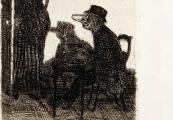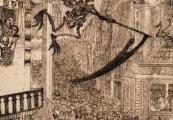Deze gearchiveerde website ‘James Ensor. Een online museum.’ wordt tijdelijk niet meer geactualiseerd. Bepaalde functionaliteiten (vb. gericht zoeken in de collectie) zijn hierdoor mogelijk niet meer beschikbaar. Nieuwsupdates over James Ensor verschijnen voortaan op vlaamsekunstcollectie.be. Vragen over deze website? Neem contact op via info@vlaamsekunstcollectie.be.
Masks and Skeletons
Ensor used the mask or the skeleton most of the time as a grotesque motif. Although some macabre and imaginary representations are definitely based on a production with the characteristics of a still life involving skulls, skeletons and carnival masks, such a production was camouflaged in order to get a mystifying effect, in which ‘dead things' were acting as living organisms.
James Ensor had been familiar with masks ever since he was a young child through the souvenir shop of his parents. He himself also started to collect the curiosa later on in life. Compared to his painting it is quite striking that the theme of the masks only dominates two etchings, i.e. Intrigued Masks and Annoyed Masks.
Ensor also used the motif of the 'living' skeleton on a regular basis, either holding a scythe in its hand or not. This is where he derived his local nickname 'the Grim Reaper' from. The interest for this macabre age-old iconography saw a revival during the last decades of the 19th century. Moreover, it is the symbol of Ensor's own obsession with mortality.








